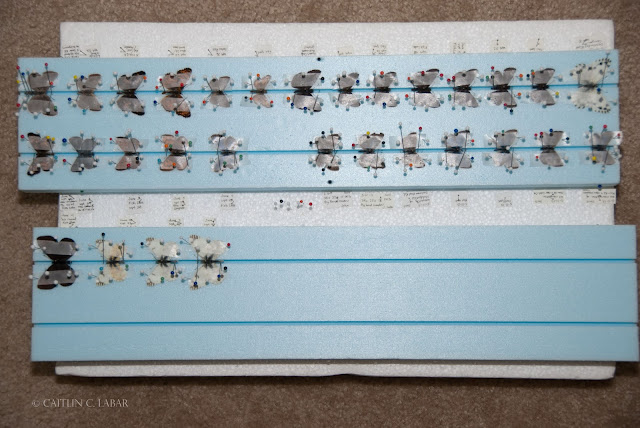Economy Pinning Boards (Blue Boards)
I highly recommend these new boards! They are a high-density polystyrene foam, which allows easy pinning, compared to the traditional wooden pinning boards that I've always had trouble with. They are also very smooth, which greatly reduces problems with rubbing scales off butterfly wings that I had with the styrofoam boards I've been using (BioQuip's Versaboard, a good product but one I'll be replacing with the new boards). The only problem I have with these new boards is that they are not deep enough to fully hold the insect pins. True, the pins do not have to be pushed so far through the board, but then the butterflies would sit only half-way up the pin, and I prefer to have them closer to the top of the pin to allow room for labels on the pin under the butterfly. So, the way I pin butterflies means that the pins stick out of the bottom of these boards about 1/8-1/4 inch. I found a way around this problem by using some of the glass-headed pins to tack the blue boards onto the back of my old versaboards as you see in the photos below (the pins are at an angle through the sides of the blue boards).
Update 5/12/2014: at the suggestion of someone at BioQuip, I attached the blue boards to 1/4" foam sheets (plastazoate or polyethylene), which works great. It provides that little extra depth I needed for the pins without being too clunky. The foam sheets can be cut to the size of the boards, or you can attach 3-4 boards to each 16x18" sheet, either with glass-headed pins or by lightly gluing them around the edges.
I also found that the new boards seem to slightly grip the wings on smaller butterflies, which greatly helped in the spreading process. For the first time I didn't have any problems spreading the wings of skippers and tiny blues! Out of all the specimens I collected on my recent trips, I didn't tear any of the wings; usually I always tear parts of at least one or two specimens using the old types of boards.
Finally, the groove sizes are so much better than the sizes on the versaboard. They have smaller groove sizes available, and these boards can fit many more butterflies than the versaboards. Here are the sizes they have available and what butterflies each size are used for.
1/16" groove (two grooves per board) - small Hesperiidae and Lycaenidae
Common Sootywing (Pholisora cattallus), skipperlings, Western Tailed Blue (Cupido comyntas), spotted blues (Euphilotes sp.), azures (Celastrina sp.), smaller specimens of Plebejus sp. and some smaller coppers and hairstreaks.
1/8" groove (two grooves per board) - most other Hesperiidae, Lycaenidae, some Pieridae/Nymphalidae
medium/large blues, coppers and hairstreaks, most skippers, small/medium pierids (Anthocaris, Euchloe, Pontia, Colias, etc), most satyrids (Coenonympha, Erebia, Cercyonis), crescents (Chlosyne, Phyciodes), small/medium checkerspots (Euphydryas).
1/4" groove (one groove per board) - fits nearly every large butterfly species we have in the northwest
All other Nymphalidae, all swallowtails should fit in this size except maybe the largest Two-tailed Swallowtails (Papilio multicaudata) or large southern/tropical species.
3/8" groove (one groove per board) - large swallowtails and medium-bodied moths
I haven't tried this size yet and don't see a need for it except for when I collect some sphinx moths or other larger species.
13/16" groove (one groove per board) - largest butterflies and moths
I also haven't tried this one, but it is intended for the largest Lepidoptera species such as the large tropical butterflies and most large moths.
 |
| Butterflies spread on "blue boards" with a 1/8" groove size |
 |
| Butterflies spread on "blue boards" with a 1/4" groove size |
After positioning the butterfly on an insect pin (long, thin black pins) and placing in a groove on the board, I position the wings using spade-tip forceps (aka stamp tongs) and pin them down with glassine paper strips and glass-headed pins. Once the wings are in place, I prop up the abdomen as necessary and carefully position the antennae close to the wings. I've found that the antennae are less likely to be knocked off later if they are close to the wings and not sticking out straight ahead.
For more information about supplies and collecting methods, refer to my "Collecting Lepidoptera" page.

First of all, thank you so much for your wonderful, informative, interesting blog. Well written, too. Second of all, thank you for this post with all of this wonderful information on the blue boards with your insights about what has been difficult for you in the past and what these do to enhance the experience of spreading the butterflies and which boards are for which butterflies. I have just started and I am dreadful, but your posts offer me a bit of hope. I have a tiny blue which I will not attempt for a long time from now, but before I came to your blog I had planned on never. I am a great fan of you!
ReplyDeleteWow, thank you! Glad to know it helps!
Delete